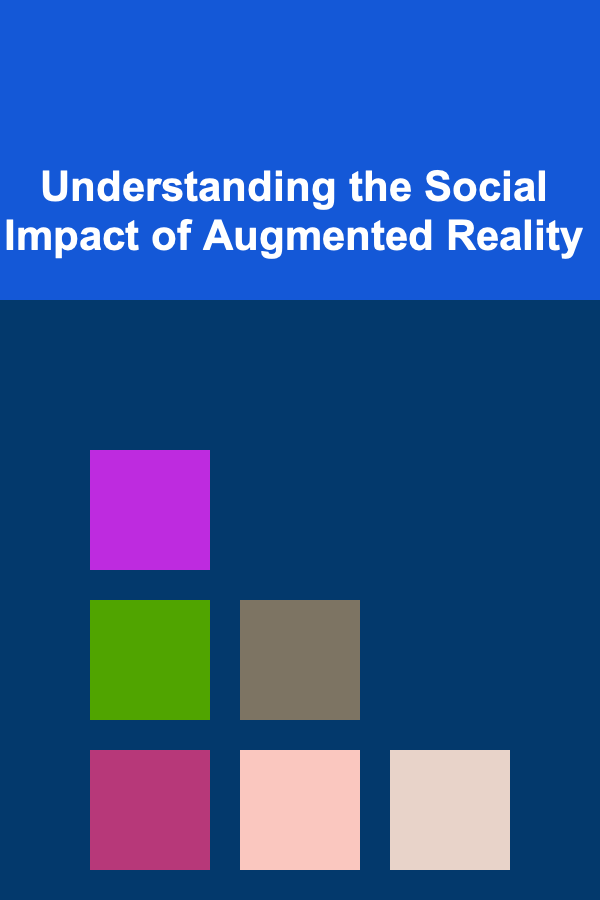
Understanding the Social Impact of Augmented Reality
ebook include PDF & Audio bundle (Micro Guide)
$12.99$9.99
Limited Time Offer! Order within the next:

Augmented Reality (AR) is rapidly evolving from a futuristic concept to a tangible technology impacting various aspects of our lives. Unlike Virtual Reality (VR), which creates immersive digital environments, AR overlays digital information onto the real world, enriching our perception and interaction with our surroundings. Understanding the social impact of AR requires a multifaceted approach, considering its potential benefits, drawbacks, and ethical implications across diverse sectors.
The Core Concepts of Augmented Reality
Before delving into the social implications, it's crucial to grasp the fundamental principles of AR. At its core, AR relies on:
- Sensors: Cameras and sensors capture data about the user's environment.
- Processors: Powerful processors analyze the sensor data and generate digital overlays.
- Displays: Screens (smartphones, tablets, smart glasses, or heads-up displays) project the augmented content onto the user's view of the real world.
- Software: Algorithms and software libraries facilitate object recognition, tracking, and the seamless integration of digital elements with the physical environment.
AR systems are categorized based on their tracking methods, including:
- Marker-based AR: Relies on specific visual markers (e.g., QR codes) to trigger and anchor the augmented content. It's often used for simpler AR applications due to its lower computational demands.
- Markerless AR: Leverages environmental features (e.g., edges, textures) for object recognition and tracking. This approach provides a more natural and seamless experience, but requires more processing power. Examples include location-based AR (using GPS and compass data) and simultaneous localization and mapping (SLAM) which builds a 3D map of the environment.
The sophistication of these technologies directly impacts the user experience and the potential social consequences.
Positive Social Impacts of Augmented Reality
AR offers a range of potential benefits that can positively transform society across various domains:
Education and Training
AR can revolutionize education and training by providing interactive and engaging learning experiences. Textbooks can come alive with 3D models, historical events can be re-enacted in front of students, and complex concepts can be visualized in an intuitive manner. For example, medical students can use AR to practice surgical procedures on virtual patients, without the risk of harming a real person.
Example: Imagine learning about the human heart. Instead of just reading about it in a textbook, AR allows students to see a 3D, beating heart floating in front of them. They can rotate it, zoom in to see the different chambers, and even simulate blood flow to understand how the heart functions.
AR also facilitates on-the-job training. Technicians can use AR headsets to receive step-by-step instructions for repairing complex machinery, guided by virtual overlays that highlight the relevant components and tools. This reduces errors, increases efficiency, and lowers training costs.
Healthcare
AR is transforming healthcare in multiple ways. Surgeons can use AR to visualize patient anatomy in 3D during procedures, improving precision and minimizing invasiveness. AR can also assist in diagnosis by overlaying medical images (e.g., X-rays, MRIs) onto the patient's body, allowing doctors to see the underlying structures in real-time.
Example: Imagine a surgeon using AR glasses to view a 3D reconstruction of a patient's tumor during surgery. This allows them to precisely target the tumor while minimizing damage to surrounding healthy tissue.
Beyond the operating room, AR can help patients manage chronic conditions. AR applications can guide patients through physical therapy exercises, provide medication reminders, and offer visual aids for individuals with cognitive impairments. It also assists in treating phobias by creating controlled environments to slowly expose individuals to their fears.
Manufacturing and Industry
In manufacturing, AR can enhance productivity and efficiency by providing workers with real-time information and guidance. AR headsets can display assembly instructions, quality control checklists, and equipment maintenance procedures directly in the worker's field of view. This reduces the need for paper-based manuals and minimizes errors.
Example: A factory worker assembling a complex engine can use AR glasses to see a virtual overlay of the engine components, highlighting which parts to install and in what order. This speeds up the assembly process and reduces the risk of mistakes.
AR also allows for remote assistance. A technician in the field can connect with an expert in the office via AR, allowing the expert to see what the technician sees and provide real-time guidance. This reduces downtime and the need for expensive travel.
Retail and E-commerce
AR is transforming the retail experience by allowing consumers to virtually try on clothes, visualize furniture in their homes, and explore products in a more interactive way. This reduces the uncertainty associated with online shopping and increases customer satisfaction.
Example: A customer can use an AR app to virtually "try on" a pair of glasses using their smartphone's camera. The app overlays the glasses onto their face, allowing them to see how they look from different angles before making a purchase. Similarly, a user can place virtual furniture in their living room to see how it fits and matches their existing decor.
AR can also enhance the in-store experience. AR-enabled displays can provide customers with additional product information, promotional offers, and interactive games. This creates a more engaging and memorable shopping experience.
Accessibility and Inclusion
AR has the potential to significantly improve accessibility for individuals with disabilities. AR applications can provide real-time translation of text and speech, enhance visual perception for people with low vision, and assist in navigation for individuals with mobility impairments.
Example: An AR app can translate signs and menus into a user's native language in real-time, helping tourists or individuals with language barriers navigate unfamiliar environments. Similarly, AR glasses can highlight obstacles and provide audio cues to assist visually impaired individuals in navigating crowded streets.
Moreover, AR can create more inclusive learning environments by providing personalized learning experiences tailored to individual needs and learning styles.
Negative Social Impacts of Augmented Reality
Despite its potential benefits, AR also presents several potential negative social consequences that need careful consideration:
Privacy Concerns
AR devices collect a vast amount of personal data, including location, gaze tracking, and biometric information. This data can be used to track users' movements, preferences, and even their emotional state. The potential for misuse and abuse of this data raises serious privacy concerns. For example, advertisers could use gaze tracking data to determine which products a user is most interested in, and then bombard them with targeted ads. Furthermore, governments could use AR data for surveillance purposes.
Example: Imagine an AR headset constantly recording your gaze and location data. This data could be used to create a detailed profile of your interests, habits, and social interactions. If this data were to fall into the wrong hands, it could be used for malicious purposes, such as identity theft or discrimination.
Furthermore, the always-on nature of AR devices raises concerns about covert surveillance. It may be difficult for individuals to know when they are being recorded or tracked by an AR device, especially if the device is disguised as ordinary eyewear.
Social Isolation and Addiction
Over-reliance on AR can lead to social isolation and addiction. Spending excessive time immersed in augmented environments can disconnect individuals from the real world and weaken their social bonds. The constant stream of digital information and stimulation provided by AR can also be addictive, leading to withdrawal symptoms and negative consequences for mental and physical health.
Example: Imagine someone spending hours each day playing AR games or interacting with virtual avatars, neglecting their real-life relationships and responsibilities. This could lead to feelings of loneliness, anxiety, and depression.
The persuasive design of many AR applications can further exacerbate these problems. Game developers and social media companies may use techniques such as rewards, notifications, and social pressure to encourage users to spend more time in their AR environments.
Digital Divide and Inequality
Access to AR technology is not evenly distributed, creating a digital divide. The high cost of AR devices and the need for reliable internet connectivity can exclude individuals from low-income communities and developing countries. This can exacerbate existing inequalities in education, employment, and access to information.
Example: Children from wealthier families may have access to AR-enhanced learning tools, while children from poorer families do not. This could widen the achievement gap and limit the opportunities available to disadvantaged students.
Furthermore, the content and applications available in AR may be biased towards certain demographics, further marginalizing underrepresented groups.
Misinformation and Manipulation
AR can be used to spread misinformation and manipulate people's perceptions of reality. Sophisticated AR applications can create realistic but false scenarios, blurring the lines between the real and the virtual. This can be used to deceive individuals, influence their opinions, and even incite violence.
Example: Imagine an AR application that overlays fake news stories onto real-world objects, such as billboards or buildings. This could be used to spread propaganda and incite hatred against certain groups. Or, consider an AR application that creates a false sense of danger in a specific location, causing people to panic and flee.
The ability to seamlessly integrate fake information into the real world makes it particularly difficult for individuals to discern truth from falsehood in an AR environment. This poses a significant challenge to critical thinking and media literacy.
Job Displacement
The automation capabilities of AR can lead to job displacement in certain industries. AR-enhanced robots and automated systems can perform tasks previously done by human workers, reducing the need for manual labor. This can lead to unemployment and economic hardship for affected workers.
Example: In the manufacturing industry, AR-guided robots can perform assembly tasks with greater speed and precision than human workers. This could lead to job losses for factory workers who lack the skills to operate and maintain these robots.
While AR may also create new job opportunities in fields such as AR development and content creation, it is important to consider the potential impact on vulnerable workers and implement policies to mitigate job displacement.
Safety Concerns
Using AR devices while performing tasks that require focus, such as driving or walking, can be dangerous. Distractions caused by AR overlays can impair judgment and increase the risk of accidents. The potential for injury is further amplified when users become overly engrossed in the augmented environment and lose awareness of their surroundings. For example, someone playing an AR game while walking down the street may not notice oncoming traffic or obstacles in their path.
Example: Using AR navigation while driving could lead to distracted driving and increase the risk of accidents. Similarly, using AR for construction or maintenance work could create safety hazards if the user's attention is diverted from the task at hand.
Clear guidelines and regulations are needed to ensure the safe use of AR devices in potentially hazardous environments.
Ethical Considerations
The development and deployment of AR technology raise several ethical considerations that need to be addressed proactively:
Transparency and Consent
Users should be fully informed about the data that AR devices collect and how that data is used. Clear and concise privacy policies are essential, and users should have the right to control their data and opt out of data collection. Furthermore, developers should obtain informed consent before using AR to track users' movements or collect biometric data.
Bias and Fairness
AR algorithms and content should be designed to be fair and unbiased. Developers should be aware of the potential for algorithmic bias to perpetuate existing inequalities and take steps to mitigate these biases. Furthermore, AR content should be inclusive and representative of diverse cultures and perspectives.
Accessibility
AR technology should be accessible to all users, regardless of their abilities or disabilities. Developers should design AR applications with accessibility in mind, providing alternative input methods, adjustable font sizes, and audio descriptions for visual content.
Accountability
There needs to be clear accountability for the misuse of AR technology. Developers, manufacturers, and platform providers should be held responsible for the harm caused by their products and services. This requires the development of legal frameworks and regulatory oversight to address the ethical challenges posed by AR.
Security
AR systems must be secured against hacking and data breaches. Protecting user data and preventing unauthorized access to AR devices are crucial to maintaining trust and preventing harm. Strong security measures, such as encryption and authentication protocols, should be implemented to safeguard user privacy and data security.
Mitigating the Negative Impacts and Fostering Responsible AR Development
Addressing the potential negative impacts of AR requires a collaborative effort involving researchers, developers, policymakers, and the public. Here are some strategies for mitigating risks and fostering responsible AR development:
- Promote privacy-preserving technologies: Develop and implement technologies that minimize data collection and protect user privacy. This includes techniques such as differential privacy, federated learning, and homomorphic encryption.
- Develop ethical guidelines and standards: Establish clear ethical guidelines and standards for AR development and deployment. These guidelines should address issues such as privacy, bias, accessibility, and accountability.
- Educate the public: Increase public awareness about the potential benefits and risks of AR. Promote media literacy and critical thinking skills to help people discern truth from falsehood in AR environments.
- Encourage interdisciplinary research: Foster collaboration between researchers from different disciplines, including computer science, ethics, law, and social sciences. This will help to identify and address the complex social and ethical challenges posed by AR.
- Support regulatory oversight: Develop appropriate legal frameworks and regulatory oversight to address the ethical challenges posed by AR. This includes regulations related to data privacy, safety, and consumer protection.
- Promote user empowerment: Give users greater control over their data and their AR experience. This includes providing users with the ability to customize their privacy settings, filter content, and report harmful or misleading information.
- Invest in accessibility: Prioritize the development of accessible AR technologies that benefit individuals with disabilities. This includes funding research and development of assistive AR devices and promoting inclusive design practices.
The Future of AR and Society
AR is poised to become an increasingly integral part of our lives, transforming the way we interact with the world around us. As AR technology continues to evolve, it is crucial to address the social and ethical challenges it presents proactively. By fostering responsible innovation, promoting public awareness, and implementing appropriate safeguards, we can harness the transformative potential of AR while mitigating its potential risks. The future of AR depends on our ability to navigate these complexities and ensure that AR benefits all of humanity.
The key is to approach AR with a balanced perspective, acknowledging its potential benefits while remaining vigilant about its potential drawbacks. A thoughtful and collaborative approach will be essential to shaping a future where AR enhances our lives without compromising our values or exacerbating existing inequalities.

How to Overcome Writer's Block While Writing Part-Time from Home
Read More
How to Throw a Fun and Relaxed Brunch Party at Home
Read More
The HR Business Partner's Playbook: Driving Organizational Success Through Talent
Read More
How to Reduce Cholesterol Naturally with Food
Read More
How to Plan Your First Budget Trip: A Comprehensive Guide
Read More
How to Create Intricate Celtic Knot Carvings
Read MoreOther Products

How to Overcome Writer's Block While Writing Part-Time from Home
Read More
How to Throw a Fun and Relaxed Brunch Party at Home
Read More
The HR Business Partner's Playbook: Driving Organizational Success Through Talent
Read More
How to Reduce Cholesterol Naturally with Food
Read More
How to Plan Your First Budget Trip: A Comprehensive Guide
Read More